disruptor笔记之六:常见场景
欢迎访问我的GitHub
https://github.com/zq2599/blog_demos
内容:所有原创文章分类汇总及配套源码,涉及Java、Docker、Kubernetes、DevOPS等;
《disruptor笔记》系列链接
本篇概览
- 本文是《disruptor笔记》系列的第六篇,主要内容是将一些常用的消费模式做汇总,后续日常开发中如果有需要就能拿来即用;
- 以下是常用的模式:
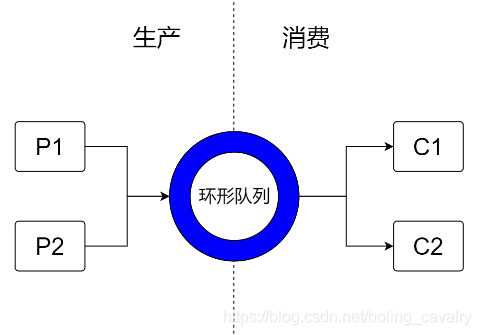
- C1、C2独立消费,C3依赖C1和C2
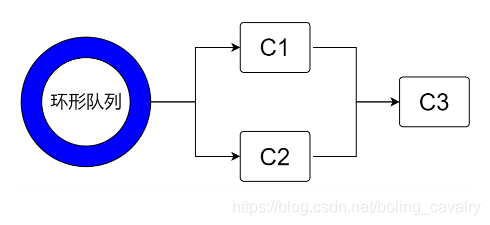
- C1独立消费,C2和C3也独立消费,但依赖C1,C4依赖C2和C3:
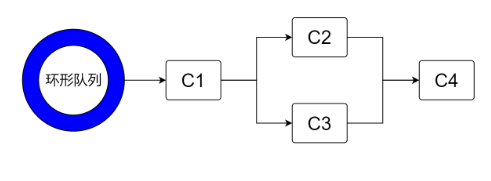
- C1和C2独立消费,C3和C4也是独立消费,但C3和C4都依赖C1和C2,然后C5依赖C3和C4:
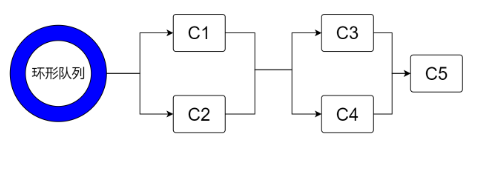
- C1和C2共同消费,C3和C4也是共同消费,但C3和C4都依赖C1和C2,然后C5依赖C3和C4:
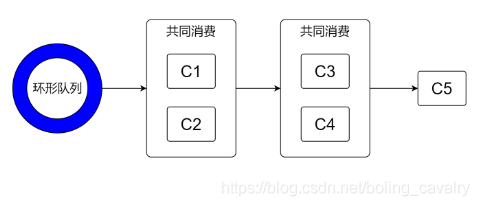
- C1和C2共同消费,C3和C4独立消费,但C3和C4都依赖C1和C2,然后C5依赖C3和C4:
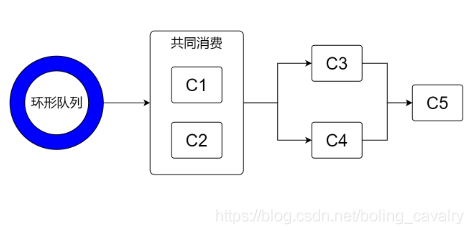
- C1和C2独立消费,C3和C4是共同消费,但C3和C4都依赖C1和C2,然后C5依赖C3和C4:

关于本篇代码
- 为了省事儿,本次不会新建工程,而是直接使用前文的consume-mode模块,因此,下面这些类直接就直接使用了,无需重写代码:
- 事件定义:OrderEvent
- 事件工厂:OrderEventFactory
- 事件生产者:OrderEventProducer
- 用在独立消费场景的事件消费者:MailEventHandler
- 用在共同消费场景的事件消费者:MailWorkHandler
源码下载
- 本篇实战中的完整源码可在GitHub下载到,地址和链接信息如下表所示(https://github.com/zq2599/blog_demos):
| 名称 | 链接 | 备注 |
|---|---|---|
| 项目主页 | https://github.com/zq2599/blog_demos | 该项目在GitHub上的主页 |
| git仓库地址(https) | https://github.com/zq2599/blog_demos.git | 该项目源码的仓库地址,https协议 |
| git仓库地址(ssh) | git@github.com:zq2599/blog_demos.git | 该项目源码的仓库地址,ssh协议 |
- 这个git项目中有多个文件夹,本次实战的源码在disruptor-tutorials文件夹下,如下图红框所示:

- disruptor-tutorials是个父工程,里面有多个module,本篇实战的module是consume-mode,如下图红框所示:
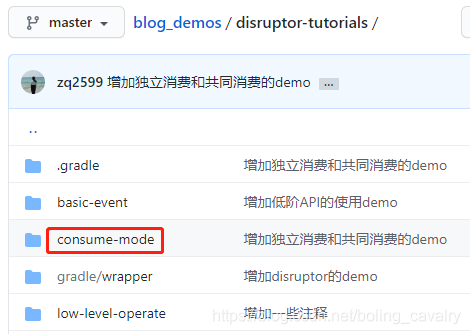
多个生产者和多个独立消费者
咱们即将实现下图的逻辑:

- 前面几篇文章所有实战的生产者都只有一个,到了本篇,为了让consume-mode模块的代码能够支持多生产者,咱们要对功能业务的抽象父类做以下两处改动:
init方法原本为private型,现在为了能让子类重此方法,将其改为protected类型;
增加名为publishWithProducer2的方法,可见内部只有抛出异常,要想其正常工作,需要子类自己来实现:
public void publishWithProducer2(String value) throws Exception {
throw new Exception("父类未实现此方法,请在子类中重写此方法后再调用");
}
- 为了实现多生产者功能,新增MultiProducerServiceImpl.java,有几处要注意的地方稍后会提到:
package com.bolingcavalry.service.impl;
import com.bolingcavalry.service.*;
import com.lmax.disruptor.BlockingWaitStrategy;
import com.lmax.disruptor.dsl.Disruptor;
import com.lmax.disruptor.dsl.ProducerType;
import lombok.Setter;
import org.springframework.scheduling.concurrent.CustomizableThreadFactory;
import org.springframework.stereotype.Service;
import javax.annotation.PostConstruct;
@Service("multiProducerService")
public class MultiProducerServiceImpl extends ConsumeModeService {
/**
* 第二个生产者
*/
@Setter
protected OrderEventProducer producer2;
@PostConstruct
@Override
protected void init() {
// 实例化
disruptor = new Disruptor<>(new OrderEventFactory(),
BUFFER_SIZE,
new CustomizableThreadFactory("event-handler-"),
// 生产类型是多生产者
ProducerType.MULTI,
// BlockingWaitStrategy是默认的等待策略
new BlockingWaitStrategy());
// 留给子类实现具体的事件消费逻辑
disruptorOperate();
// 启动
disruptor.start();
// 第一个生产者
setProducer(new OrderEventProducer(disruptor.getRingBuffer()));
// 第二个生产者
setProducer2(new OrderEventProducer(disruptor.getRingBuffer()));
}
@Override
protected void disruptorOperate() {
// 一号消费者
MailEventHandler c1 = new MailEventHandler(eventCountPrinter);
// 二号消费者
MailEventHandler c2 = new MailEventHandler(eventCountPrinter);
// 调用handleEventsWithWorkerPool,表示创建的多个消费者以共同消费的模式消费
disruptor.handleEventsWith(c1, c2);
}
@Override
public void publishWithProducer2(String value) throws Exception {
producer2.onData(value);
}
}
- 上述代码有以下几处要注意:
- 重写父类的init方法,主要是实例化Disruptor的时候,多传入两个参数:ProducerType.MULTI表示生产类型是多生产者,BlockingWaitStrategy是等待策略,之前的代码中咱们没有传此参数时,默认的就是BlockingWaitStrategy
- init方法中还执行了setProducer2方法,设置成员变量producer2
- 重写publishWithProducer2方法,调用成员变量producer2发表事件
- 重写disruptorOperate方法,里面设置了两个独立消费者
- 验证上述代码的方式依旧是单元测试,打开ConsumeModeServiceTest.java,新增以下代码,可见新增了两个线程同时执行发布事件的操作:
@Autowired
@Qualifier("multiProducerService")
ConsumeModeService multiProducerService;
@Test
public void testMultiProducerService() throws InterruptedException {
log.info("start testMultiProducerService");
CountDownLatch countDownLatch = new CountDownLatch(1);
// 两个生产者,每个生产100个事件,一共生产两百个事件
// 两个独立消费者,每人消费200个事件,因此一共消费400个事件
int expectEventCount = EVENT_COUNT*4;
// 告诉service,等消费到400个消息时,就执行countDownLatch.countDown方法
multiProducerService.setCountDown(countDownLatch, expectEventCount);
// 启动一个线程,用第一个生产者生产事件
new Thread(() -> {
for(int i=0;i<EVENT_COUNT;i++) {
log.info("publich {}", i);
multiProducerService.publish(String.valueOf(i));
}
}).start();
// 再启动一个线程,用第二个生产者生产事件
new Thread(() -> {
for(int i=0;i<EVENT_COUNT;i++) {
log.info("publishWithProducer2 {}", i);
try {
multiProducerService.publishWithProducer2(String.valueOf(i));
} catch (Exception e) {
e.printStackTrace();
}
}
}).start();
// 当前线程开始等待,前面的service.setCountDown方法已经告诉过service,
// 等消费到expectEventCount个消息时,就执行countDownLatch.countDown方法
// 千万注意,要调用await方法,而不是wait方法!
countDownLatch.await();
// 消费的事件总数应该等于发布的事件数
assertEquals(expectEventCount, multiProducerService.eventCount());
}
- 测试结果如下,测试通过,符合预期:

C1、C2独立消费,C3依赖C1和C2
- 逻辑图如下:

- 实现代码如下,非常简单,依赖关系用then即可实现:
package com.bolingcavalry.service.impl;
import com.bolingcavalry.service.ConsumeModeService;
import com.bolingcavalry.service.MailEventHandler;
import com.bolingcavalry.service.MailWorkHandler;
import com.bolingcavalry.service.SmsEventHandler;
import org.springframework.stereotype.Service;
@Service("scene5")
public class Scene5 extends ConsumeModeService {
@Override
protected void disruptorOperate() {
MailEventHandler c1 = new MailEventHandler(eventCountPrinter);
MailEventHandler c2 = new MailEventHandler(eventCountPrinter);
MailEventHandler c3 = new MailEventHandler(eventCountPrinter);
disruptor
// C1、C2独立消费
.handleEventsWith(c1, c2)
// C3依赖C1和C2
.then(c3);
}
}
- 单元测试代码:
@Autowired
@Qualifier("scene5")
Scene5 scene5;
@Test
public void testScene5 () throws InterruptedException {
log.info("start testScene5");
testConsumeModeService(scene5,
EVENT_COUNT,
// 三个独立消费者,一共消费300个事件
EVENT_COUNT * 3);
}
- 为了节省篇幅,测试结果就不贴了,要注意的是,每个事件都一定是C1和C2先消费过,才会被C3消费到;
C1独立消费,C2和C3也独立消费,但依赖C1,C4依赖C2和C3
- 逻辑图如下:

- 实现代码如下:
package com.bolingcavalry.service.impl;
import com.bolingcavalry.service.ConsumeModeService;
import com.bolingcavalry.service.MailEventHandler;
import org.springframework.stereotype.Service;
@Service("scene6")
public class Scene6 extends ConsumeModeService {
@Override
protected void disruptorOperate() {
MailEventHandler c1 = new MailEventHandler(eventCountPrinter);
MailEventHandler c2 = new MailEventHandler(eventCountPrinter);
MailEventHandler c3 = new MailEventHandler(eventCountPrinter);
MailEventHandler c4 = new MailEventHandler(eventCountPrinter);
disruptor
// C1
.handleEventsWith(c1)
// C2和C3也独立消费
.then(c2, c3)
// C4依赖C2和C3
.then(c4);
}
}
- 单元测试代码:
@Autowired
@Qualifier("scene6")
Scene6 scene6;
@Test
public void testScene6 () throws InterruptedException {
log.info("start testScene6");
testConsumeModeService(scene6,
EVENT_COUNT,
// 四个独立消费者,一共消费400个事件
EVENT_COUNT * 4);
}
C1和C2独立消费,C3和C4也是独立消费,但C3和C4都依赖C1和C2,然后C5依赖C3和C4
- 逻辑图如下:

- 实现代码如下:
package com.bolingcavalry.service.impl;
import com.bolingcavalry.service.ConsumeModeService;
import com.bolingcavalry.service.MailEventHandler;
import org.springframework.stereotype.Service;
@Service("scene7")
public class Scene7 extends ConsumeModeService {
@Override
protected void disruptorOperate() {
MailEventHandler c1 = new MailEventHandler(eventCountPrinter);
MailEventHandler c2 = new MailEventHandler(eventCountPrinter);
MailEventHandler c3 = new MailEventHandler(eventCountPrinter);
MailEventHandler c4 = new MailEventHandler(eventCountPrinter);
MailEventHandler c5 = new MailEventHandler(eventCountPrinter);
disruptor
// C1和C2独立消费
.handleEventsWith(c1, c2)
// C3和C4也是独立消费,但C3和C4都依赖C1和C2
.then(c3, c4)
// 然后C5依赖C3和C4
.then(c5);
}
}
- 单元测试代码:
@Autowired
@Qualifier("scene7")
Scene7 scene7;
@Test
public void testScene7 () throws InterruptedException {
log.info("start testScene7");
testConsumeModeService(scene7,
EVENT_COUNT,
// 五个独立消费者,一共消费500个事件
EVENT_COUNT * 5);
}
C1和C2共同消费,C3和C4也是共同消费,但C3和C4都依赖C1和C2,然后C5依赖C3和C4
- 逻辑图如下:

- 实现代码如下:
package com.bolingcavalry.service.impl;
import com.bolingcavalry.service.ConsumeModeService;
import com.bolingcavalry.service.MailEventHandler;
import com.bolingcavalry.service.MailWorkHandler;
import org.springframework.stereotype.Service;
/**
* @author will (zq2599@gmail.com)
* @version 1.0
* @description: C1和C2共同消费,C3和C4也是共同消费,但C3和C4都依赖C1和C2,然后C5依赖C3和C4
* @date 2021/5/23 11:05
*/
@Service("scene8")
public class Scene8 extends ConsumeModeService {
@Override
protected void disruptorOperate() {
MailWorkHandler c1 = new MailWorkHandler(eventCountPrinter);
MailWorkHandler c2 = new MailWorkHandler(eventCountPrinter);
MailWorkHandler c3 = new MailWorkHandler(eventCountPrinter);
MailWorkHandler c4 = new MailWorkHandler(eventCountPrinter);
MailWorkHandler c5 = new MailWorkHandler(eventCountPrinter);
disruptor
// C1和C2共同消费
.handleEventsWithWorkerPool(c1, c2)
// C3和C4也是独立消费,但C3和C4都依赖C1和C2
.thenHandleEventsWithWorkerPool(c3, c4)
// 然后C5依赖C3和C4
.thenHandleEventsWithWorkerPool(c5);
}
}
- 单元测试代码:
@Autowired
@Qualifier("scene8")
Scene8 scene8;
@Test
public void testScene8 () throws InterruptedException {
log.info("start testScene8");
testConsumeModeService(scene8,
EVENT_COUNT,
// C1和C2共同消费,C3和C4共同消费,C5虽然只是一个,但也是共同消费模式,
// 也就是一共有三组消费者,所以一共消费300个事件
EVENT_COUNT * 3);
}
C1和C2共同消费,C3和C4独立消费,但C3和C4都依赖C1和C2,然后C5依赖C3和C4
- 逻辑图如下:

- 实现代码如下:
package com.bolingcavalry.service.impl;
import com.bolingcavalry.service.ConsumeModeService;
import com.bolingcavalry.service.MailEventHandler;
import com.bolingcavalry.service.MailWorkHandler;
import org.springframework.stereotype.Service;
@Service("scene9")
public class Scene9 extends ConsumeModeService {
@Override
protected void disruptorOperate() {
MailWorkHandler c1 = new MailWorkHandler(eventCountPrinter);
MailWorkHandler c2 = new MailWorkHandler(eventCountPrinter);
MailEventHandler c3 = new MailEventHandler(eventCountPrinter);
MailEventHandler c4 = new MailEventHandler(eventCountPrinter);
MailEventHandler c5 = new MailEventHandler(eventCountPrinter);
disruptor
// C1和C2共同消费
.handleEventsWithWorkerPool(c1, c2)
// C3和C4独立消费,但C3和C4都依赖C1和C2
.then(c3, c4)
// 然后C5依赖C3和C4
.then(c5);
}
}
- 单元测试代码:
@Autowired
@Qualifier("scene9")
Scene9 scene9;
@Test
public void testScene9 () throws InterruptedException {
log.info("start testScene9");
testConsumeModeService(scene9,
EVENT_COUNT,
// C1和C2共同消费(100个事件),
// C3和C4独立消费(200个事件),
// C5独立消费(100个事件),
// 所以一共消费400个事件
EVENT_COUNT * 4);
}
C1和C2独立消费,C3和C4是共同消费,但C3和C4都依赖C1和C2,然后C5依赖C3和C4
- 逻辑图如下:

- 实现代码如下:
package com.bolingcavalry.service.impl;
import com.bolingcavalry.service.ConsumeModeService;
import com.bolingcavalry.service.MailEventHandler;
import com.bolingcavalry.service.MailWorkHandler;
import org.springframework.stereotype.Service;
@Service("scene10")
public class Scene10 extends ConsumeModeService {
@Override
protected void disruptorOperate() {
MailEventHandler c1 = new MailEventHandler(eventCountPrinter);
MailEventHandler c2 = new MailEventHandler(eventCountPrinter);
MailWorkHandler c3 = new MailWorkHandler(eventCountPrinter);
MailWorkHandler c4 = new MailWorkHandler(eventCountPrinter);
MailEventHandler c5 = new MailEventHandler(eventCountPrinter);
disruptor
// C1和C2共同消费
.handleEventsWith(c1, c2)
// C3和C4是共同消费,但C3和C4都依赖C1和C2
.thenHandleEventsWithWorkerPool(c3, c4)
// 然后C5依赖C3和C4
.then(c5);
}
}
- 单元测试代码:
@Test
public void testScene10 () throws InterruptedException {
log.info("start testScene10");
testConsumeModeService(scene10,
EVENT_COUNT,
// C1和C2独立消费(200个事件),
// C3和C4共同消费(100个事件),
// C5独立消费(100个事件),
// 所以一共消费400个事件
EVENT_COUNT * 4);
}
- 至此,一些常见场景的代码已完成,希望本文能给您一些参考,帮您更得心应手的用好这个优秀的工具;
你不孤单,欣宸原创一路相伴
欢迎关注公众号:程序员欣宸
微信搜索「程序员欣宸」,我是欣宸,期待与您一同畅游Java世界...
https://github.com/zq2599/blog_demos
disruptor笔记之六:常见场景的更多相关文章
- disruptor笔记之二:Disruptor类分析
欢迎访问我的GitHub https://github.com/zq2599/blog_demos 内容:所有原创文章分类汇总及配套源码,涉及Java.Docker.Kubernetes.DevOPS ...
- disruptor笔记之三:环形队列的基础操作(不用Disruptor类)
欢迎访问我的GitHub https://github.com/zq2599/blog_demos 内容:所有原创文章分类汇总及配套源码,涉及Java.Docker.Kubernetes.DevOPS ...
- disruptor笔记之四:事件消费知识点小结
欢迎访问我的GitHub https://github.com/zq2599/blog_demos 内容:所有原创文章分类汇总及配套源码,涉及Java.Docker.Kubernetes.DevOPS ...
- disruptor笔记之五:事件消费实战
欢迎访问我的GitHub https://github.com/zq2599/blog_demos 内容:所有原创文章分类汇总及配套源码,涉及Java.Docker.Kubernetes.DevOPS ...
- disruptor笔记之七:等待策略
欢迎访问我的GitHub https://github.com/zq2599/blog_demos 内容:所有原创文章分类汇总及配套源码,涉及Java.Docker.Kubernetes.DevOPS ...
- disruptor笔记之八:知识点补充(终篇)
欢迎访问我的GitHub https://github.com/zq2599/blog_demos 内容:所有原创文章分类汇总及配套源码,涉及Java.Docker.Kubernetes.DevOPS ...
- disruptor笔记之一:快速入门
欢迎访问我的GitHub https://github.com/zq2599/blog_demos 内容:所有原创文章分类汇总及配套源码,涉及Java.Docker.Kubernetes.DevOPS ...
- 【Visual C++】游戏编程学习笔记之六:多背景循环动画
本系列文章由@二货梦想家张程 所写,转载请注明出处. 本文章链接:http://blog.csdn.net/terence1212/article/details/44264153 作者:ZeeCod ...
- [oracle]TX行锁发生的常见场景(转贴)
TX行锁发生的常见场景: 1.当前会话要更新或删除的记录,已经被其他会话更新或删除. 2.对于表上有唯一索引的情况,多个会话插入或更新为相同的键值. 3.对于表上有位图索引的情况,多个会话即使更新不同 ...
随机推荐
- 本文详细阐述如何用C#创建COM组件,并能用VC6.0等调用。
本文详细阐述如何用C#创建COM组件,并能用VC6.0等调用. 附:本文适用任何VS系列工具. 在用C#创建COM组件时,一定要记住以下几点: 1.所要导出的类必须为公有: 2.所有属性.方法也必须为 ...
- vs2019 快捷键汇总
https://docs.microsoft.com/zh-cn/visualstudio/ide/default-keyboard-shortcuts-for-frequently-used-com ...
- C#设计模式---迭代器模式(Iterator Pattern)
一.目的 提供一种方法访问一个容器对象中各个元素,而又不需暴露该对象的内部细节. 二.定义 迭代器模式提供了一种方法访问一个聚合对象(理解为集合对象)中各个元素,而又无需暴露该对象的内部表示,这样既可 ...
- C++ 各种构造函数
c++构造函数的知识在各种c++教材上已有介绍,不过初学者往往不太注意观察和总结其中各种构造函数的特点和用法,故在此我根据自己的c++编程经验总结了一下c++中各种构造函数的特点,并附上例子,希望对初 ...
- JavaWeb学习总结——使用Session防止表单重复提交
在平时开发中,如果网速比较慢的情况下,用户提交表单后,发现服务器半天都没有响应,那么用户可能会以为是自己没有提交表单,就会再点击提交按钮重复提交表单,我们在开发中必须防止表单重复提交. 一.表单重复提 ...
- 刷题-力扣-213. 打家劫舍 II
213. 打家劫舍 II 题目链接 来源:力扣(LeetCode) 链接:https://leetcode-cn.com/problems/house-robber-ii/ 著作权归领扣网络所有.商业 ...
- 编程读写CAD文件验证
背景 B/S应用系统,根据用户上传数据:业务数据和CAD坐标数据,经过一系列运筹算法运算后,输出一批坐标数据,作为给用户的规划结果.此时需要方便直观的给用户展示坐标数据.可选方式有两个: web页面画 ...
- idea配置tomcat及中文乱码解决
放在前面:不要使用tomcat10,访问自己的页面会报404错误,目前无解,在这个坑爬了一下午,最终换了tomcat 9才解决.所以我选择了tomcat 9 + idea 2021.2版本 配置步骤: ...
- adb 常用命令大全(7)- 其他实用功能
屏幕截图 adb exec-out screencap -p > sc.pn 截图保存到电脑执行该命令的目录下 如果指定文件名以 .png 结尾时可以省略 -p 参数 注意 如果 adb 版本较 ...
- Gitlab - 安装的社区版 Gitlab-ce,解决访问网页报502-Whoops, GitLab is taking too much time to respond的问题
问题背景 在自己虚拟机(centos7)上装了 Gitlab-ce,就是社区版的 Gitlab,版本是 13.0+ 问题描述 浏览器访问 Gitlab 网站,报 502 问题翻译 502-Whoops ...
